 I am sure you have asked that question of yourself numerous times! Co-director of PTGC Lawrie Montague and I have had same question put to us by parents, players, State and National golf associations and player management agents and the answer is always the same 10 Year Rule!! How do I know this! In my player development program the same pattern has unfolded time and time again with Michael Sim starting his development program as a 11 year old and getting his US Tour card at 21 years old. Kim Felton starting as a 12 year old and becoming World no.1 amateur at 23 years old, Tanya Holl and Dana Lacey same 10 year cycle to achieve status on the European Ladies Tour. I have seen it happen too many times for it to be chance so when I read Karl Anders Ericsson work and his finding that every expert in every field is the result of around ten thousand hours of committed practice it all made sense. 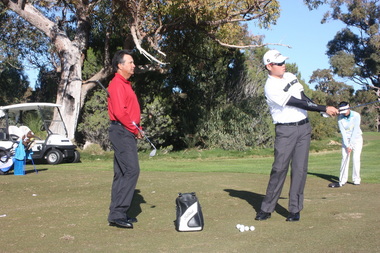 This committed practice he named "deliberate practice" which x 10,000 hours = World Class Skill. There are also numerous other factors that need to be linked with the above equation to enable a person to achieve world class skill and the same rules apply if they are a chess player, painter, piano player, math or writer. What about genius's you may ask, or those who are born with more talent? The answer is Tiger Woods started swinging a club at 2 years old but from the time he started competing in tournaments to winning the US Amateur it was that same 10 year rule. Even the chess prodigy Bobby Fisher put in 9 years of hard work before he achieved his Grand Master status at 17 years of age. Both these individuals had the "burning obsessive desire" to be the very best, the perfect training enviroment and had Master Coaches on hand to guide them.  So what is deliberate practice? Here's an exercise for you to try and it will help you understand the difference between "ordinary practice" and "deliberate practice". Take some time to view list A and B below spending the same amount of time on each list. When you are done turn away from the computer screen and recall as many of the word pairs as you can and write them down. From which column do you recall more words? A B
chair / couch car / b_s fruit / vegetable road / l_ne high school / college l_nch / dinner television / radio church / m_sque computer / chip b_x /carton steak / chips boat / ocean_ iner forrest / trees be_r / wine petrol / engine river / b_oat hotel / motel pen_il / paper movie / actress clouds / s_y If you are like most people you will recall more words from column B. The difference is you experienced a micro-second of struggle and that made all the difference. This is the "kicker;" you did not practice harder when you looked at column B you just "practiced deeper". Now all the successful players Lawrie and I have worked with through the years have had the ability to "practice deeper". That is the reason why we have been successful with our players development as it's been our understanding that "if you train like you play, then you play like you train". All our training systems and programs have been developed with that one goal in mind to create the enviroment for our players to understand the "state" they have to be in to make their training beneficial and meaningful. The emphasis is always on growing skills with deliberate practice which takes energy, passion and committment and 10,000 hours over 10 years. Broken down its 1,000 hours per year, 83.3 hours per month, 19.2 hours per week and 3.2 hours per day for 6 days. Even the most committed golfers have one day off each week. Here at PTGC we train 5 hours per day, 5 days per week with all the ingredients of deliberate practice here for golfers attending our programs to experience and understand; the tried and tested formula of Deliberate Practice x 10,000 hours = World Class skills Good Golfing Lawrie Montague & David Milne 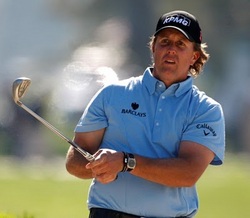 What is the difference between playing golf for fun and playing golf in a competition? Not a lot really. Many of the golfers we work with at our college struggle with the process of learning how to shoot lower-more competitive scores when they are competing. When they are relaxed and playing a sociable game with their friends they tell us that they play much better and score lower than the times when they are competing in a tournament. When professional golfers play golf on tour they are required to play four round events because they only get paid when they complete four rounds of golf successfully. The trouble is that they have to play to a very high standard every week and particularly in the first and second round. This poses somewhat of a problem for many young and inexperienced professionals because in their minds they think they need a lot of experience before they start to perform consistently for four days. I don’t agree with this. I believe that you can fast-track the “playing for experience” process by focusing your mental energy on developing effective modelling strategies that get to the heart of performing better faster.  What do I mean when I say “modelling strategies?” We build mental models or maps of all our experiences and we use these maps to get us back to places we want to be and also places we don’t want to be. That’s right; they will also take us to places we don’t want to go. For many golfers, their “competition model” takes them to places they don’t want to be i.e. higher scores, frustration and feelings of helplessness that makes it difficult for them to make cuts and win prize money whereas their non-competition model takes them to lower scores that seem easier to achieve. Basically you need to understand that there is a distinction between the times when you compete where you feel satisfied with your results and the times when you compete and you don’t.  Your map of higher scores and the feelings associated with it is something you fight to stay away from which might seem logical and sensible to you, however you need to understand that this is not about logic. There is nothing logical about not playing to your potential as no amount of logic or positive thinking will make you feel better about playing sub-standard golf. What you need to do is design a competition model that leads you to consistent lower golf scores and at the same time develops your self-image and self esteem. Think of any consistent routine as a model. The routine is an experience that you have packaged up so that you can use it again and again. "Driving the kids to school at the same time each day, along the same route is an example of a consistent routine many people execute." You have literally hundreds of routines or models of experience that you use to get through your life safely and with few mistakes. Driving the kids to school at the same time each day, along the same route is an example of a consistent routine many people execute. Think about it like this; nearly everything you do in your life is done effortlessly and seamlessly. In other words, it’s relatively easy and you make few if any mistakes. And yet the one routine you’ve spent a great deal of your life time perfecting is the one your struggle with the most. Driving your car on the other side of the road is a challenge (particularly in traffic) and yet it will seems easier to do for many golfers than stringing four consistent rounds of golf together. Why do we try so hard to do something that you can already do so well? It actually doesn’t make a lot of sense does it?  I believe that part of the reason is appreciating how the context and content of an experience influences your existing competition model. The difference in experience between two events is that the context is different and the content is different. Here’s two examples:
Now I know that this is a simplistic attempt to help you to understand that the content of your experience makes up your experience and when slightly different can lead you to different outcomes. So the question is this; Is it useful and even helpful for you to you to see it this way? Let’s look at it again: Context #1. Playing a round of golf with friends and enjoying the experience which leads to better performances and more fun Context #1. Trying to play well in a golf tournament which leads to higher scores and no fun Is there a difference between playing golf and trying to play golf? You bet there is, the difference is massive! 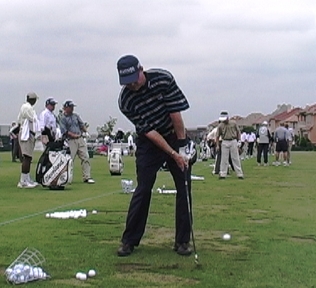 Remember this; you are not wrong or broken in some way. Golfers use the word ‘fix’ often when describing some aspect their performance that is not up to par. The word fix implies broken or in need of repair, but you are not broken, you are carrying out your current strategies perfectly, however it’s just possible that your strategies (which form the content of your model) may be poorly designed and ineffective. Golfers who are currently performing more the way you want to in a golf tournament are more than likely using more effective and useful strategies built around well constructed models that define the context and content of the experience they’re striving for, and which can be repeated consistently because they have developed a clearly defined map which is harmonious with their future goals. When you build a competition model that taps into the golf skills and potential you already possess, you will start to perform more the way you want to. The paradigm of playing as much golf as possible to get better is not a useful strategy unless you develop your strategy with content that taps into your existing skills and golfing experience.
Remember that you have all the resources you need already to play golf the way you truly want to. So build a better map of the experience you wish to have by carefully adding content to it that will lead you to lower golf scores, better results in tournaments and ultimately a lot more fun. It’s not impossible because there are plenty of golfers already doing it the way you want to, so take a leaf from their experience and add it to yours. Do it today, do it now, and get on with playing golf in competition just the way you want to play it. Lawrie Montague and David Milne Your Success On Tour is Our Business  You will work hard at Pro Tour Golf College. The core concept behind the college is to "train to perform," so every bit of energy is devoted to moving the golf ball from one place to another with improvement in mind. To achieve this outcome we track, test, measure and manage every golf shot hit at the college and carefully scrutinize the results to develop the most suitable plan for improvement. The main ingredients in the Pro Tour Golf College performance mix are high golf stroke volume; strict management of time; varying training intensity and on-going technical improvement. Day three at PTGC was golf course assessment morning with the guys playing nine holes so we could get an idea of the way they go about constructing a round of golf. Joondalup Dune and Quarrie courses is the original 18 holes and a supreme test of golf from the blue markers and it really tested the guys patience and golf skills. After the morning on the golf course we had a debrief session in the clubhouse to discuss the students perceptions of the way they performed on the golf course. Two of the students that are members of the college are in the middle of making minor changes to their golf swing technique which certainly challenged their comfort zone. I made the point of explaining a simple but powerful concept that I wanted them to remember: "When you react you reinforce." Reacting to less than desireable golf shots will reinforce the negative behaviour that you are actually trying to eliminate. 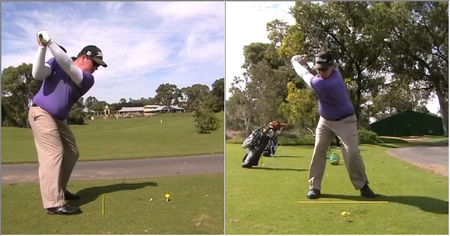 HIGH SPEED VIDEO ANALYSIS Using high speed video is a great way to help a student to understand an important concept in their golf swing technique and can also be a really good tool for generating confidence. After the round and debrief we went down to the range to capture their golf swings from two angles simultaneously to create a visual record of changes we will make to their technique over time. The point we continually make is that your golf score is much more important than how good your golf swing looks. Our main objective with golf swing technique work is to essentially develop three important factors in their golf swing technique.
"No one every got paid for a pretty golf swing..." You get paid to shoot consistently low golf scores and this is an important point that we continually make to our students. The students attending the college are at different phases of their development cycle but regardless of where they are they need to develop the low golf score paradigm.  GOLF SWING TARGETING ASSESSMENT On Thursday the students hit one hundred and fifty golf shots to targets ranging from 80 metres to 220 metres with two targets for each distance set at a pre-determined diametre. The objective of this training exercise was to measure the accuracy of their golf shots with the different clubs in their bag so we could determine which distances they were confident and competent at and which distances they weren't. Following is the distance/diametre targetting schedule and the golf strokes they played. 80 - 90 metres at 8m wide ---------------------- 20 golf shots 100 - 110 metres at 10m wide ----------------- 20 golf shots 120 - 130 metres at 12m wide ----------------- 20 golf shots 140 - 150 metres at 14m wide ----------------- 20 golf shots 160 - 170 metres at 16m wide ----------------- 20 golf shots 180 - 190 metres at 18m wide ----------------- 20 golf shots 200 - 210 metres at 20m wide ----------------- 20 golf shots 220 - metres at 22m wide ----------------------- 10 golf shots TOTAL GOLF SHOTS ASSESSED 150 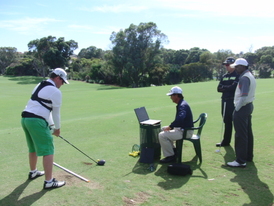 PRE-SHOT ROUTINE AND SEGMENT TIME ASSESSMENT After the PTGC students finished their targetting assessment they hit another fifty golf shots which we measured with a stop watch to determine how consistent their pre-shot routine was. The pre-shot routine focus window is between 10 and 15 seconds and we studied the students as they hit various shots to determine whether their routine would stand up to the pressure of competing. At the same time this was happening David was using one of our K-Vests to get a 3D perspective on their golf swing technique. The K-Vest system precisely measures swing efficiency and movement patterns in three dimensions. The real-time visual and auditory feedback keeps our PTGC students on track with their technique development because they can monitor and track their progress accurately over time. TOTAL GOLF SHOTS ASSESSED 60 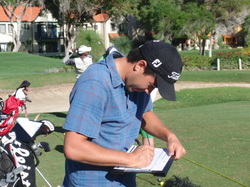 SUMMARY OF FIRST WEEK So let's have a look at the first week (4 Days) of Pro Tour Golf College and the great work the students put into their game. Monday - Putting Skills Assessment ----------------------- 250 Putts Tuesday - Greenside Skills Assessment ------------------ 200 Shots Wednesday - Golf Course Assessment and Video ------ 50 Shots Thursday - Full-Swing Assessment/PSR/K-Vest ------- 210 Shots Total 710 Golf Shots We hope you can see that PTGC is for serious amateur and professional golfers who want to work hard and are committed to their goal of lowering their golf score average so they can become competitive golfers on a professional golf tour. Until next time. David Milne and Lawrie Montague P.S Our next semester starts in early July so if you're considering joining PTGC send us an email today. 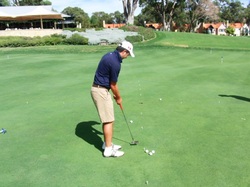 After months of planning and preparation Pro Tour Golf College launched this week. The brain child of David Milne and Lawrie Montague two of Australia's most experienced and well known golf teaching professionals, the college was developed to help prepare highly advanced male and female golfers from around the world for a life as a touring professional golfer. Students in the program are trained from 8am to 1pm Monday to Friday and are exposed to a high intensive training environment specifically designed to help condition them mentally, emotionally and technically for a life as a touring professional. To give you an idea of what the students have already been exposed to this week, here's the schedule for the first two days. ASSESSMENT WEEK This week is assessment week or data collection week where we test and measure the students skills sets. As its a long weekend we are training for 4 days this week with most of the students playing in the Easter tournament in Mandurah on the weekend. Monday ------------Putting skills Tuesday -----------Greenside skills Wednesday ------Golf course skills Thursday ----------Full-swing skills 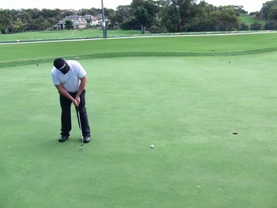 MONDAY - PUTTING SKILLS PROGRAM On Monday the students were subjected to a comprehensive putting skills assessment where they hit short and long putts ranging from 1 metre to 25 metres. This was an intensive experience but gave them a great undertanding of how to train to perform. Following is the program outline wihich consisted of a total of 250 putts hit over 3.5 hours. 40 putts from 1 metre to 4 metres on a level to slightly sloped green 40 putts from 10 metres to 25 metres on a level to slightly sloped green 40 putts from 1 metre to 4 metres uphill 40 putts from 1 metre to 4 metres downhill 40 putts from 1 metre to 4 metres left to right 40 putts from 1 metre to 4 metres right to left 10 putts from 2 metres using TOMI putting system 250 Putts in Total  TOMI PUTTING TRAINING DEVICE TOMI is the only personalized putting training device that captures the critical parameters of our students putting stroke in real-time. From this data, TOMI can instantly tell us what we need to do to dramatically improve our students putting stroke. Our students will use TOMI to provide them with the feedback they need to improve their putting stroke and lower their putting average. 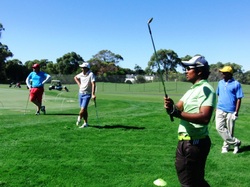 TUESDAY - GREENSIDE SKILLS PROGRAM Today the students played 200 hundred chip/pitch/lob and bunker shots from challenging positions around the practice green. It was every bit as intensive as the first day on the putting green. Following is an outline of the types of shots played and the distances they were played from. 40 - 10 metre to 25 metre chip shots 40 - 15 metre to 30 metre pitch shots 40 - 10 metre to 25 metre lob shots 40 - 15 metre to 30 metre trouble shots (rough) 40 - 10 metre to 25 metre bunker shots 200 Shots in Total  18 HOLE GREENSIDE SKILLS CHALLENGE After the students completed their scheduled program they participated in an 18 hole short-game skills challenge where they played one golf shot from 18 different positions around the green (All moderate to difficult shots). The winner of the challenge was ultimately decided by measuring the proximity of every golf shot struck by each student on each hole and then the total distance in metres was divided by 18 holes which gave an average distance from the hole for each student. The winning golfer averaged just 2.2 metres from the hole after 18 shots, an excellent result and the winner by the narrowest of margins only 24 centimetres. This type of practice is an encellent routine for engaging the golfers competitive instincts leading into the weekend tournament and is also a great way to wind down after the intensity of the rigorous training schedule. 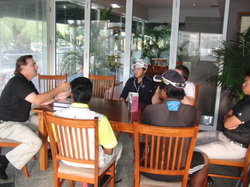 THE DEBRIEF At the end of every training session we get together for thirty minutes to go over the program and discuss the effects of the day's program on each golfer. Here's one of the comments from Sam Crawford one of our PTGC students: "I found that todays program really required patience. The demand of the program is to dig deep, stay in the zone and have complete focus.This to me is one of the most important aspects to master if I want to be competitive, therefore I am confident that this program and process of training will give me the best opportunity to reach my goals." Tomorrow we have an 18 hole golf course assessment where we get to see first hand how the students handle the golf course and themselves. That should be interesting. We look forward to keeping you updated with the progress of the students in the PTGC program. David Milne and Lawrie Montague  There’s no doubt about it; whether you want to play on one of the PGA tours or one of the women’s professional golf tours you are going to have to be a great wedge player. You have to have the ability to control the distance you hit your wedges to within a yard or two of where you’re aiming to hit it if you want to increase your chances of succeeding on a professional golf tour. In this video golf instruction lesson David Milne two times Australian PGA golf teacher of the year and co-director of Pro Tour Golf College will show you the correct way to play to play a sixty yard approach wedge shot that will increase your par and birdie average and lead you to lower golf scores. We hope that you enjoyed this video golf instruction lesson and hope that it helps you to hit your wedges closer to the hole so you can produce lower golf scores and becao
 If you watch golf tournaments on TV you would quickly realise that the best golfers playing on the PGA tours are experts at playing bunker shots. In fact Luke Donald after a full season playing on the PGA tour averaged only 7 feet from the hole which is an incredible feat when you consider all the different bunker shots he faced in a full season playing on tour. You should be aiming to get your ball up and down out of the greenside bunkers sixty percent of the time. Our expectation of the students at Pro Tour Golf College is that this is the minimum standard you should be striving to achieve. In this video golf instruction lesson David Milne co-director of Pro Tour Golf College, and one of the world's leading golf instructors and tour coach to young rising PGA tour star Michael Sim will show you how to play the double chance bunker shot. You can visit our new Pro Tour Golf College Video channel now at www.youtube.com/user/ProTourGolfCollege where you will find advanced golf video instruction lessons covering all the scoring shots on and around the green that will lead you to lower golf scores.
David and Lawrie  One of the most important putting skills that you can learn and develop and the one the pro’s who play golf on tour work very hard on is controlling the speed of their putt across the putting green surface. PGA tour golfers know that long putting is an important skill to master as many of their putts are from 15 to 35 feet from the hole. Reducing the 3 putt tendency in your golf game is possible by controlling your long putting over straight and curved surfaces confidently. In this video golf instruction lesson David will show you the correct way to practice long putting with the progressive distance putting drill so you can become confident and confident over your putts from 15 feet to 35 feet. Practice the progressive distance putting drill often and you will notice a significant difference in your approach putting and ultimately your golf scores.
David and Lawrie  There is a simple formula that can explain the level of success you have achieved in your life thus far. I was extremely fortunate to attend a business seminar more than twenty years ago where I first came across this amazingly simple formula and armed with it I have been able to improve many areas of my life and also those of my students. When I was starting out as a young golf professional I spent a great deal of my time practicing and trying to improve my golf skills without any form of success pathway to guide me. "I always wondered why some golfers seemed to achieve more success than others given that in many cases the more successful golfer wasn't working at their game near as hard." What was it that they were doing that seemed to make all the difference? Some years later when I began my career as a full time golf instructor my mentor suggested that I start to attend business seminars to develop my golf teaching business. I took his advice and started to attend as many seminars as I could and listen to different experts discuss the best strategies for improving the bottom line of your business. This suggestion and my subsequent action changed my life as I quickly realised that the business world is every bit as competitive as the professional golf tours and that business people were well schooled in understanding the process that led to business success.  It was at one of these seminars that a very famous business speaker and expert in developing human performance potential Brian Tracy revealed a simple formula for success that quite frankly changed the way I lived my life. He started by writing the formula (to the right) on a white board and asked the audience to work out what they thought it meant. After a lot of guesses he explained to the large audience that the formula was so simple and elegant that many people would simply pass it off as being simplistic and consequently many in the audience (before they left the seminar) would pay little to no attention to it, and he was absolutely correct. "I sincerely hope that you will pay attention to it..." I on the other hand wrote it down and really thought about it and in the beginning I believed that I understood what it meant, but I realised that the more I thought about it the more it revealed to me about what it takes to succeed. 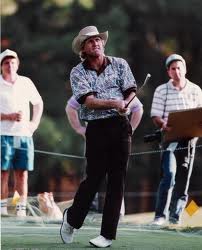 Was this the reason why Greg Norman was the dominant golfer in the World at the time? It made sense that he was doing things a little bit differently to everyone else. Of course the golf media described his extraordinary abilities on the golf course as God given gifts or rare talent and yet I knew that he started playing golf much later than other golfers and seemed to get better faster. "Did the formula explain why he and other great golfers got so good so fast?" Greg Norman was producing outstanding results playing on the same golf course as many other highly skilled golfers and yet was able to dominate many of the events he played in. Tiger Woods has also had the ability to do this and as I studied the formula what became apparent was that the formula explained that the results they were producing were controlled by two elements; the effort they applied and the level of understanding they possessed.  V.J Singh got to number one in the world after forty years of age competing against tour professionals nearly half his age and he came from the small Island of Fiji. He wasn't a product of a traditional junior golf development background but he found a way to the top. V.J has always had a reputation for working harder at his game than the mojority of his peers but I already knew that hard work helped. This wasn't the complete answer...  When you look at the formula you have Results at one end and Effort at the other. Applying effort to your game will produce a result, there's no doubt about it. The big question is, is it the result you desire. If the answer is no then we need to look at the middle part of the formula for guidance. The middle part of the formula is Understanding and in producing desireable results we need to develop the correct level of understanding to achieve them, or at the very least get closer to it. One definition of understanding is that it's the limit of a concept. To understand something you have to be able to conceptualize it to a given measure. To not understand how to improve your golf score is the limit of your knowledge about how to improve your golf skills so that it would lead you to improvement in your golf score. In his essay "The Limits of Reason", Gregory Chaitin, a noted computer scientist argues that understanding something means being able to figure out a simple set of rules that explains it. (http://en.wikipedia.org/wiki/Understanding) When you hit a golf shot you are required to know how to play the shot. Your knowledge of how to play the shot determines to a great extent your level of understanding. "What are the rules you use to to be able to hit a wedge shot from sixty yards out to within 10 feet of the pin 70 percent of the time?" This amazing and simple formula will work for you one hundred percent of the time in your golf game or any other area of your life where your desire for improvement. Remember this though. "Do not put effort into improving your golf game if you don't really know what you're doing." Remember that the key is to realise that the result you desire requires that your level of understanding to be at least the same; and the effort you employ is designed to compliment the level of understanding and results you're striving for. If you study and apply the formula r = u x e you will experience the results you want faster and more effectively than any other way. So give it a shot and let us know here at Pro Tour Golf College how the "Golf Success Formula" works for you. Lawrie Montague 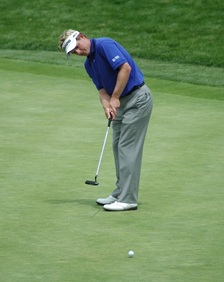 PGA Tour golfer Luke Donald leads the putting statistic described as "3 Putt Avoidance." All the great putters who play golf on tour rarely 3 putt because they are very good at controlling the speed of their putts across the putting green consistently. Every tour golfer knows how important it is to avoid 3 putting and the 3 Putt Avoidance statistic shows the tour players who are the best at avoiding 3 putts during the season. This is a statistic you should pay particular attention to because it's a great indicator of your ability to control speed over distance which is a very important skill to develop if you want to develop your competitive capabilties. In this video golf instruction lesson David Milne from Pro Tour Golf College and tour coach to PGA tour golfer Michael Sim is going to show you a simple and easy to perform distance control putting drill to help you avoid 3 putts. David Milne and The 3 Putt Avoidance Drill We hope you enjoyed this video golf instruction lesson and we'll have more quality lessons for you to learn how to lower your golf score average in the following weeks. Good Golfing David Milne |
Archives
June 2019
|
Proudly Supported By
Copyright © 2011 - 2018 Pro Tour Golf College
Website Managed By Golf Performance Media
All Rights Reserved
Website Managed By Golf Performance Media
All Rights Reserved


 RSS Feed
RSS Feed



